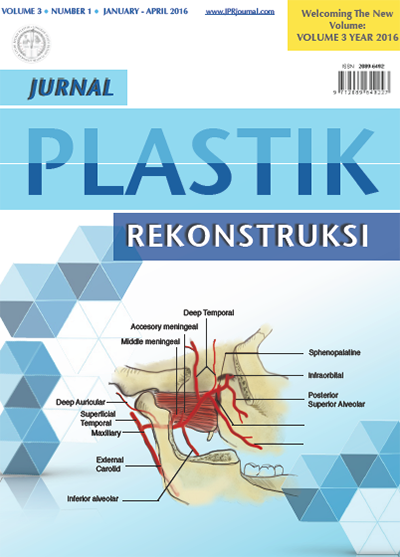Simple Metric Measurement To Choose A keystone Flap Design On Extremities: A Cadaveric Study
DOI:
https://doi.org/10.14228/jpr.v3i1.193Abstract
Background: Closing defect on extremities can be challenging because of limited donor area in order to obtain similar quality, color, texture, and adequate size with the defect. The keystone flap has gained popularity as a tool for local reconstruction because of its simple design, short operative time, good aesthetic outcome, and cost-effective wound closure. The aim of this study is to introduce a method in choosing a keystone flap design based on simple metric measurement resulting in lower tension..
Methods: Four circular defects were created on 4 different regions of a fresh cadaver’s upper limbs. Diameters were 5 cm for upper arms and 3 cm for lower arms. Two options of keystone flaps designs were introduced. The keystone could be advanced in longitudinal manner or in transversal manner according to limb’s axis. We then calculated the percentage of the skin required to stretch, in order to close the defects. The less percentage of skin required to stretch between the two manners indicated the lower tension of the keystone flap.
Results: Measurements in all of 4 regions of upper limbs showed that the percentage of skin stretch in closing the defects was lower in longitudinal advancement keystone flap compared to transversal advancement (19.88% versus 27.8% for upper arms and 15.71% versus 21.67% for lower arms)
Conclusion: Simple metric measurements in choosing a keystone flap can be applied to defects on extremities. With less tension when raising the keystone flap, acceptable scar is expected and the occurrence of contracture and flap necrosis can be reduced.
Downloads
Published
Issue
Section
License
Copyright (c) 2016 Jurnal Plastik Rekonstruksi

This work is licensed under a Creative Commons Attribution-NonCommercial-NoDerivatives 4.0 International License.
Authors retain the copyright of the article and grant Jurnal Plastik Rekonstruksi the right of first publication with the work simultaneously licensed under a Creative Commons Attribution License. Articles opting for open access will be immediately available and permanently free for everyone to read, download and share from the time of publication. All open access articles are published under the terms of the Creative Commons Attribution-Non-commercial-NoDerivatives (CC BY-NC-ND) which allows readers to disseminate and reuse the article, as well as share and reuse of the scientific material. It does not permit commercial exploitation or the creation of derivative works without specific permission.














